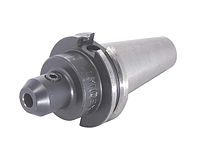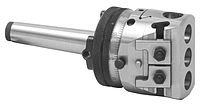UTeM BMFR Google Search Engine

Most CNC milling machines or machining centers are computer controlled vertical mills with the ability to move the spindle vertically along the Z-axis. This extra degree of freedom permits their use in diesinking, engraving applications, and 2.5D surfaces such as relief sculptures. When combined with the use of conical tools or a ball nose cutter, it also significantly improves milling precision without impacting speed, providing a cost-efficient alternative to most flat-surface hand-engraving work.

CNC machines can exist in virtually any of the forms of manual machinery, like horizontal mills. The most advanced CNC milling-machines, the 5-axis machines, add two more axes in addition to the three normal axes (XYZ). Horizontal milling machines also have a C or Q axis, allowing the horizontally mounted workpiece to be rotated, essentially allowing asymmetric and eccentric turning. The fifth axis (B axis) controls the tilt of the tool itself. When all of these axes are used in conjunction with each other, extremely complicated geometries, even organic geometries such as a human head can be made with relative ease with these machines. But the skill to program such geometries is beyond that of most humans. Therefore, 5-axis milling machines are practically always programmed with CAM.
With the declining price of computers, free operating systems such as Linux, and open source CNC software, the entry price of CNC machines has plummeted. For example, Sherline, Prazi, and others make desktop CNC milling machines that are affordable by hobbyists.
Milling machine tooling
There is some degree of standardization of the tooling used with CNC Milling Machines and to a much lesser degree with manual milling machines.
CNC Milling machines will nearly always use SK (or ISO), CAT, BT or HSK tooling. SK tooling is the most common in Europe, while CAT tooling, sometimes called V-Flange Tooling, is the oldest variation and is probably still the most common in the USA. CAT tooling was invented by Caterpillar Inc. of Peoria, Illinois in order to standardize the tooling used on their machinery. CAT tooling comes in a range of sizes designated as CAT-30, CAT-40, CAT-50, etc. The number refers to the Association for Manufacturing Technology (formerly the National Machine Tool Builders Association (NMTB)) Taper size of the tool.
An improvement on CAT Tooling is BT Tooling, which looks very similar and can easily be confused with CAT tooling. Like CAT Tooling, BT Tooling comes in a range of sizes and uses the same NMTB body taper. However, BT tooling is symmetrical about the spindle axis, which CAT tooling is not. This gives BT tooling greater stability and balance at high speeds. One other subtle difference between these two toolholders is the thread used to hold the pull stud. CAT Tooling is all Imperial thread and BT Tooling is all Metric thread. Note that this affects the pull stud only, it does not affect the tool that they can hold, both types of tooling are sold to accept both Imperial and metric sized tools.
SK and HSK tooling, sometimes called "Hollow Shank Tooling", is much more common in Europe where it was invented than it is in the United States. It is claimed that HSK tooling is even better than BT Tooling at high speeds. The holding mechanism for HSK tooling is placed within the (hollow) body of the tool and, as spindle speed increases, it expands, gripping the tool more tightly with increasing spindle speed. There is no pull stud with this type of tooling.
The situation is quite different for manual milling machines — there is little standardization. Newer and larger manual machines usually use NMTB tooling. This tooling is somewhat similar to CAT tooling but requires a drawbar within the milling machine. Furthermore, there are a number of variations with NMTB tooling that make interchangeability troublesome.
Two other tool holding systems for manual machines are worthy of note: They are the R8 collet and the Morse Taper #2 collet. Bridgeport Machines of Bridgeport, Connecticut so dominated the milling machine market for such a long time that their machine "The Bridgeport" is virtually synonymous with "Manual milling machine." The bulk of the machines that Bridgeport made from about 1965 onward used an R8 collet system. Prior to that, the bulk of the machines used a Morse Taper #2 collet system.
As an historical footnote: Bridgeport is now owned by Hardinge Brothers of Elmira, New York.
Labels: CNC, Manufacturing, Milling Machine
















